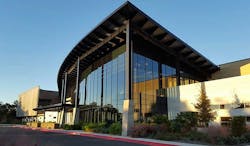The growth of the data center industry continues in the Pacific Northwest, which is about to get another new player. Colocation specialist CyrusOne says it is scouting properties in the region to boost its presence on the West Coast.
“We are currently looking at an 80-acre parcel of land up in the Pacific Northwest to be able to provide customers with a product that would work for them there,” said Gary Wojtaszek, the President and CEO of CyrusOne, on the company’s recent earnings call.
The Pacific Northwest has seen a data center boom over the past decade, with major clusters emerging in Quincy, Washington and several locations in Oregon, especially rural Prineville and the Portland suburb of Hillsboro.
The region offers a number of attributes coveted by data center builders, including cheap renewable power, a climate that supports fresh-air cooling, and opportunities for favorable tax treatment.
Wojtaszek said the Pacific Northwest offers a low total cost of ownership for data center users. “We believe we need that type of arrow in our quiver to satisfy the demands for those customers that are looking for high compute deployments that are less sensitive to the latency side,” he said. “And we think once we have that in place, we’ll be able to attack a section of the market that we could not otherwise play in.”
Quincy Expands Power Capacity
Wojtaszek didn’t say where CyrusOne is hoping to build. But a clue may be found in an announcement this week by a utility in the region.
The Grant County Public Utility District said it will be building two new electrical power substations in the Port of Quincy to support new industrial customers. The Quincy Plains substation will be a 41 MVA substation dedicated to a single customer – a capacity typical of a data center. A second new substation, known as Cloudview, is being built to support a new industrial customer, but will have capacity to support several additional industrial users.
An aerial view of Quincy, Washington, with a number of large data centers visible. (Photo: Port of Quincy)
Quincy, a rural town of 7,200 residents, is home to six major data centers spanning about 2 million square feet of space, including cutting-edge facilities operated by Microsoft and Yahoo. Enterprise users include Intuit and Dell, while Quincy also has two wholesale data center operators, Vantage and Sabey.
Development in Quincy got a boost last year when the state of Washington extended incentives that exempted data centers from sales and use taxes on servers and power infrastructure. Shortly afterward, both Sabey and Yahoo commenced major expansions of their campuses in Quincy.
Another possibility is Oregon, which has also been boosted by the growth of the data center industry. Facebook and Apple have data centers in Prineville in central Oregon, while Portland has seen strong growth for multi-tenant providers, including INFOMART, Digital Realty, T5 Data Centers and ViaWest. DuPont Fabros Technology recently acquired land in Hillsboro for a new data center.
Build to Suit Opportunity
CyrusOne operates 1.6 million square feet of space across its 30 data center properties throughout the U.S., and has another 400,000 square feet under development. In the first quarter, the company leased 25 megawatts and 181,000 square feet of space.
The company has seen strong leasing from large users, and believes that the Pacific Northwest will be ideal for these type of customers.
“Everything we do is on a multi-tenant basis, but we believe that in the Pacific Northwest, there will be single tenant opportunities where those customers are taking down a really large section of a building,” said Wojtaszek. “So the whole facility or campus is going to be multi-tenant, but we would go there with a dedicated customer in tow before we would put any capital in the ground in that particular location.”
Wojtaszek told securities analysts that CyrusOne will continue to review opportunities to expand into new markets, both domestic anf international.
“Our view has always been that this industry is global by nature,” he said. “Data goes everywhere around the world all the time and our customers are large multinationals with a presence all over the world. So long-term, strategically, we believe we need to have a bigger presence around the world, and we will be there eventually. But that is of secondary priority to us relative to the expansion plans that we’re focused on in the U.S.”
About the Author



